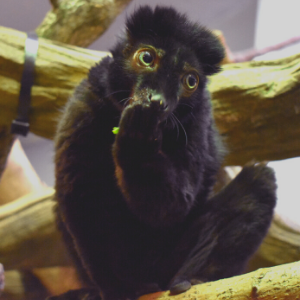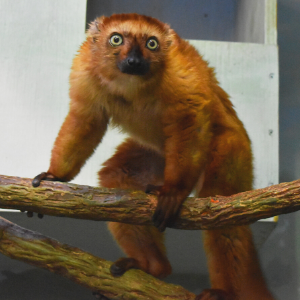Since 1953, the Akron Zoo has connected your life with wildlife by introducing you to animal species from around the world. Because of this, we are always overjoyed when a new species joins the Akron Zoo family, especially when that species is of high priority to the Association of Zoos and Aquariums (AZA).
 At the end of 2019, the Akron Zoo became home to two blue-eyed black lemurs, Murphy and McKinnon. These lemurs are a priority species for the AZA because the population in their natural habitat and in human care are both critically low. The species, which is estimated to contain fewer than 1,000 individuals, is severely threatened by hunting, trapping and deforestation. They are even at risk in their protected habitat, Sahamalaza National Park, Madagascar, thanks to wildfires and other natural threats.
At the end of 2019, the Akron Zoo became home to two blue-eyed black lemurs, Murphy and McKinnon. These lemurs are a priority species for the AZA because the population in their natural habitat and in human care are both critically low. The species, which is estimated to contain fewer than 1,000 individuals, is severely threatened by hunting, trapping and deforestation. They are even at risk in their protected habitat, Sahamalaza National Park, Madagascar, thanks to wildfires and other natural threats.
Efforts to breed this species in human care began in the mid-1990s, when four native born animals were brought to the Duke Lemur Center in North Carolina. Since then, the population in human care has slowly grown under the guidance of the Prosimian Taxon Advisory Group (TAG), a group of zoo staff invested in the healthy management of the prosimian population in human care. Today there are only 31 individuals in AZA facilities around the world. Their Species Survival Plan (SSP) is “Red,” making them the highest priority for population diversification and growth. This is why our participation in the conservation of this species is essential.
 “This species brings a TON to our zoo,” says keeper Liz Wilfong. “Because our zoo is now one of only ten AZA accredited zoos to house blue-eyed black lemurs, we have the unique opportunity to educate people about how important the species is. They bring a greater diversity to our zoo, and they are interacting well with our ring-tailed lemurs, who they are sharing a habitat with.”
“This species brings a TON to our zoo,” says keeper Liz Wilfong. “Because our zoo is now one of only ten AZA accredited zoos to house blue-eyed black lemurs, we have the unique opportunity to educate people about how important the species is. They bring a greater diversity to our zoo, and they are interacting well with our ring-tailed lemurs, who they are sharing a habitat with.”
The new arrivals, Murphy and McKinnon, are siblings, so they will not be a breeding pair. However, by adding this species to the Akron Zoo family, we have helped to create much needed space at other zoos participating in the SSP.
Murphy, our male, is 3 years old and his sister, McKinnon, is 2 years old. They are easy to tell apart since blue-eyed black lemurs are sexually dichromatic, meaning the color of females and males are vastly different. Females vary in shade from reddish-brown to gray, while males of the species are all black. They have long tails which they carry high in the air as they move and jump, and guests will often see them playing and leaping through their habitat.
 “Both Murphy and McKinnon are curious and energetic,” says Wilfong. “They are into pretty much any enrichment the keepers give them. They enjoy foraging through items for fruits, and they really enjoy little bits of sweets like honey. Murphy is really into mirrors and will scent mark on them, when he finds them. He is also a bit more outgoing than McKinnon, though Mckinnon was more curious about meeting Gidro and Nathan, our ring-tailed lemurs.”
“Both Murphy and McKinnon are curious and energetic,” says Wilfong. “They are into pretty much any enrichment the keepers give them. They enjoy foraging through items for fruits, and they really enjoy little bits of sweets like honey. Murphy is really into mirrors and will scent mark on them, when he finds them. He is also a bit more outgoing than McKinnon, though Mckinnon was more curious about meeting Gidro and Nathan, our ring-tailed lemurs.”
Murphy and McKinnon can be found in the Akron Zoo’s Madagascar building daily, along with our ring-tailed lemurs and red ruffed lemurs. Be sure to visit them on your next trip and welcome them to the Akron Zoo family! As always, a portion of the proceeds from your visit helps us support local and global conservation, and helps us make a difference in the lives of endangered species, like the blue-eyed black lemur!
